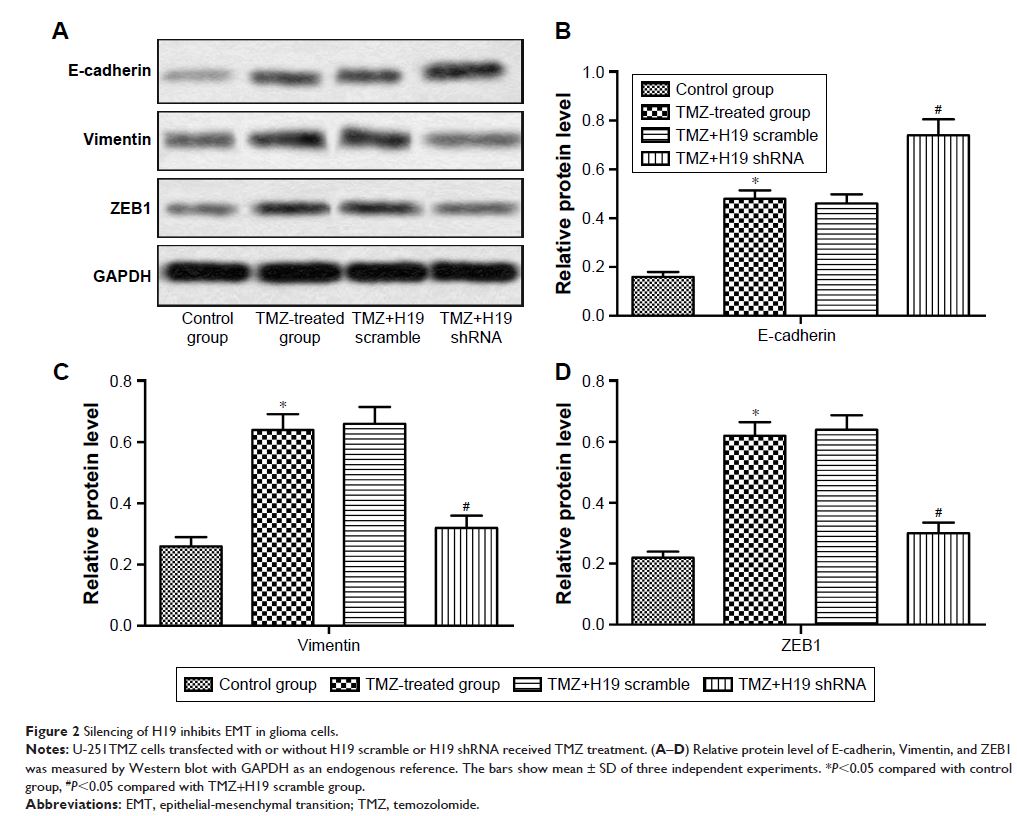9 0 8 0 2
论文已发表
注册即可获取德孚的最新动态
IF 收录期刊
- 2.6 Breast Cancer (Dove Med Press)
- 3.9 Clin Epidemiol
- 3.3 Cancer Manag Res
- 3.9 Infect Drug Resist
- 3.6 Clin Interv Aging
- 4.8 Drug Des Dev Ther
- 2.8 Int J Chronic Obstr
- 8.0 Int J Nanomed
- 2.3 Int J Women's Health
- 3.2 Neuropsych Dis Treat
- 4.0 OncoTargets Ther
- 2.2 Patient Prefer Adher
- 2.8 Ther Clin Risk Manag
- 2.7 J Pain Res
- 3.3 Diabet Metab Synd Ob
- 4.3 Psychol Res Behav Ma
- 3.4 Nat Sci Sleep
- 1.9 Pharmgenomics Pers Med
- 3.5 Risk Manag Healthc Policy
- 4.5 J Inflamm Res
- 2.3 Int J Gen Med
- 4.1 J Hepatocell Carcinoma
- 3.2 J Asthma Allergy
- 2.3 Clin Cosmet Investig Dermatol
- 3.3 J Multidiscip Healthc

LncRNA-H19 的沉默通过 Wnt/-连环蛋白途径抑制上皮 - 间质转化,从而降低人胶质瘤细胞对替莫唑胺的化学抗性
Authors Jia L, Tian Y, Chen Y, Zhang G
Received 17 October 2017
Accepted for publication 15 November 2017
Published 11 January 2018 Volume 2018:11 Pages 313—321
DOI https://doi.org/10.2147/OTT.S154339
Checked for plagiarism Yes
Review by Single-blind
Peer reviewer comments 3
Editor who approved publication: Dr Samir Farghaly
Introduction: Temozolomide (TMZ) is commonly used for glioma chemotherapy.
However, TMZ resistance limits the therapeutic effect of TMZ in glioma
treatment. LncRNA-H19 acts as an oncogenic LncRNA in some types of cancers and
has been reported to be up-regulated in glioma.
Materials and methods: In our present study, we established TMZ-resistant
glioma cells (U-251TMZ and M059JTMZ) to explore the effect of H19 on the
chemoresistance of glioma cells.
Results: We observed that the expression of H19 was
significantly increased in U-251TMZ and M059JTMZ cells. Knockdown of H19
expression using specific shRNA in U-251TMZ and M059JTMZ led to decreased half
maximal inhibitory concentration (IC50) values for TMZ
and increased cell apoptosis rates, indicating that the silencing of H19
decreased chemoresistance of glioma cells to TMZ. In addition, silencing of H19
suppressed epithelial-mesenchymal transition (EMT) by increasing the expression
of epithelial marker E-cadherin and decreasing the expression of mesenchymal
marker Vimentin and ZEB1. Moreover, inducing EMT by TGF-β1 treatment led to
increased IC50 values for TMZ and decreased cell apoptosis
rates compared with TMZ+H19 shRNA group, suggesting that the induction of EMT
counteracted the inhibitory effect of H19 shRNA on chemoresistance of glioma
cells to TMZ. Furthermore, the reduced expression of H19 down-regulated the expression
of β-Catenin and its downstream targets c-myc and Survivin in TMZ-treated
glioma cells. Activation of Wnt/β-Catenin pathway by Licl treatment promoted
EMT and enhanced chemoresistance to TMZ compared with TMZ+H19 shRNA group.
Conclusion: Taken
together, our data suggest that H19 decreased chemoresistance of glioma cells
to TMZ by suppressing EMT via the inhibition of Wnt/β-Catenin pathway. Our
study might represent a novel therapeutic target for TMZ-resistant glioma.
Keywords: LncRNA-H19,
chemoresistance, glioma, temozolomide, EMT, Wnt/β-Catenin
